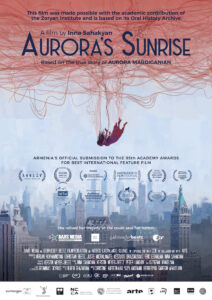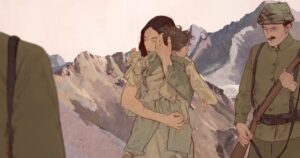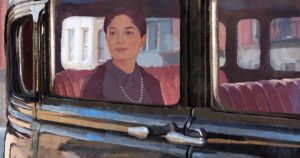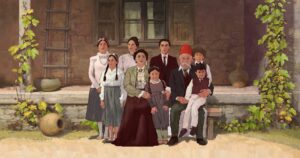Interview with “Aurora’s Sunrise” Director Inna Sahakyan
Written by: Christopher Llewellyn Reed | February 7th, 2023

Before the end of 2022, I reviewed Armenian director Inna Sahakyan’s animated documentary Aurora’s Sunrise, which tells the tale of Aurora Mardiganian (née Arshaluys), who at 17 escaped the Ottoman genocide of Armenians and came to the United States to spread the harrowing news. Shortly after writing her story for an American newspaper, she was cast as herself in a 1919 Hollywood film, Auction of Souls. The film just won the top prize at the 2023 MiradasDocs. Aurora’s Sunrise is a U.S. sales title with CAT&Docs handling sales.
I had a chance to interview Sahakyan in December, and what follows is a condensed digest of our conversation, edited for length and clarity. Sahakyan speaks fine English, though her native language is Armenian. Where I have had to adjust the language to make it fit American idioms, I have done so.
Christopher Llewellyn Reed: Why did you want to make an animated documentary and how did you assemble your animation team?

Inna Sahakyan: First of all, I never wanted to make a film about the Armenian genocide. That was never my purpose in life. As a documentary filmmaker, it’s a very hard topic to deal with. All victims have already passed away, and we are, as Armenians, becoming super sentimental when talking about this topic. But when I discovered Aurora’s story, and listened to her testimonies, they proved so interesting and amazing. Still, what was there in the archival record was just talking-head interviews, very interesting, but bad-quality video footage.
So, immediately, animation presented itself as a unique solution to tell her story. Of course, I was inspired by other animated documentaries, such as Waltz with Bashir. In such films, you have this opportunity to use imagination to distance the viewer from direct storytelling, to use symbols, colors, and at the same time, to capture this trauma through memories. That was very unique and that was one of the first decisions as soon as I become familiar with the story.
Assembling the team was a longer and more complicated process. We initially tried one style with one team that didn’t work out, using a sort of cutout style. We worked quite a while on it, but it didn’t work out at the end because when the script was locked, I realized that about 65 minutes of the film is animation. So we pivoted to an animation style that would involve the viewer more. It could not be too simple, because the story is complicated. In the end, we were able to create a great team of Arme
nian and Lithuanian illustrators and animators. The lead department came from Armenia and the key artists and animators from Lithuania. Through the collaboration, we developed this unique style that we have.
CLR: Your press notes mention the grand past of Soviet Armenian animation.
IS: Yes.
CLR: I’m more familiar with Soviet Russian animation, but it sounds like there was an equally robust tradition in Armenia, and possibly in Lithuania, too.
IS: Yes, but everyone in our team was younger, so while we knew the Soviet background, none of them worked during that time. It’s more like this background that is in your genetic memory that you know but does not directly influence you. It’s really a collaboration of different people’s artistic visions, because for example, the illustration styles, background styles come from the Lithuanian team’s suggestions. The Art Nouveau style comes from another Lithuanian artist. But at the same time, it’s adapted with Armenian colors. It’s layers of work layered over each other to create this.

CLR: So how about Auction of Souls? Had you always known about the existence of this film? If not, when did you become aware of it and of the restored footage that you feature in your own movie?
IS: Auction of Souls only became publicly available in the 2010s under another name, just 18 minutes of it. Anyone searching for Auction of Souls can find this bad-quality footage online. It’s a copy of a copy of a copy of a copy. We had to restore it ourselves for the purpose of the film.
CLR: And then when did you become aware of the surviving interviews with Aurora?
IS: That was in 2014. I was doing research on another documentary in the Zoryan Institute’s archive. The Zoryan Institute is a Canada-based human rights institute, and they have recorded, starting from the 1970s, more than 700 testimonies of genocide survivors. So I was working in the archive and listening to the testimonies. They suggested I listen to Aurora’s testimony. That was really amazing. At that time, I knew Aurora’s book, I knew about the existence of the 18 minutes of footage from Auction of Souls, but I had never looked at it from a filmmaker perspective because it was not in my mind, as I said at the start of this interview. But when I listened to her testimony and compared it with all the others that I had already listened to, it was so strong. It was not just telling the genocide story from a victim’s perspective. She was such a great storyteller.
There are two more of her testimonies that I used in the film, which are from the Armenian Film Foundation and recorded in 1975 and then again in 1984. So I had these three testimonies. While animation is the most important visual storytelling tool, these testimonies are, for me, the most important documentary storytelling tool. From the early stages of the film’s development, I knew that I wanted them to be directly involved in the film because I wanted the audience to connect with Aurora herself and let Aurora tell her own story.

CLR: You write in your press notes that “the Armenian genocide is the enduring pain of my nation,” and I do not doubt this. Making this film now, what can it tell us today?
IS: For me, it was important to tell the genocide story through the personal story of a young girl so we could learn from her experience. What really captured me in this story was her independence; she did not live by general rules. She confronted the harsh reality with her own humanity, which she kept in this inhuman situation. When I started the film, my main goal was to tell her story and to shed light on our genocide. But in 2014, 2015, there were not so many wars so close to us; there was no war in Ukraine or conflicts in Armenia.
In 2020s, we all faced another war, which is ongoing, and we are still hearing similar stories. So of course, I understand that films are not going to change the world, but I wanted to remind everyone about what was happening in history in order to learn from it, to have her as a role model of how to keep humanity in this terrible situation and learn lessons from the past. The Armenian genocide is still not recognized by Turkey. This pain will somehow be more healed once we know that it’s recognized.
CLR: I mean, it wasn’t even recognized by the United States until 2021.
IS: Exactly. I already had a rough cut of the film done when that happened, so I had to change the ending titles when it was recognized.
CLR: Some countries have been really good about recognizing their past sins, such as Germany.
IS: Absolutely.

CLR: What happened during World War II was horrific, the worst side of humanity, and yet the West German government in the 1960s was able to apologize and the modern German state is a mostly shining example of humanitarian assistance to others. Why do you think it’s so hard for a country like Turkey to acknowledge this horrific act of its past?
IS: It’s really a political question, I believe. First of all, I think Turkey should become a truly democratic country in order to face these challenges. Secondly, it creates responsibility, when you apologize, that can affect territorial claims. And then there is the guilt, which they don’t want to get into. Turkey has always worked hard, and is still working hard, to be accepted by the world and in the community and so on. I don’t think that they’re ready to publicly admit to this genocide. But, given the political structure of the country … I mean, it’s still not really democratic.
But I need to also mention that of course there are individuals, there are organizations who understand the truth and have supported the film. But they are under political pressure, and the head of one such organization is life-sentenced now and another film producer who was supporting different films is now facing a 17-sentence. It’s very tense and is getting worse, unfortunately.
CLR: Yeah. I mean, you said Turkey needs a democratic government and it’s a lot less democratic under Erdoğan than it was 10 years ago.
IS: Of course.
CLR: But what you’re saying is that individual Turks and some Turkish organizations have no problem admitting to the genocide, but politically, the government cannot.
IS: Yes. I hope that one day they will and I hope I will live to see it.

CLR: I want to end with this. Aurora says something really interesting in one of her interviews, which you saved for the end of the movie, which is that if the genocide had been recognized back in the 1910s and ‘20s, and the perpetrators had been prosecuted or called out, the Nazi Holocaust might never have happened. That’s a really bold statement, and it’s food for thought. It’s just a throwaway line, but it’s such an important statement. What are your own thoughts?
IS: Yeah, I was shocked. Aurora, of course, she had a complicated life, but she lived all her life as a simple woman. Hearing this from her, with that clarity, was so important for me because she’s basically saying, in such a simple way, that the whole heaviness of the world, like crimes and wars, continue if they are not condemned by the entire world. She was so honest and direct in this statement that I wanted to allow her to end the movie with it.
CLR: I want to thank you very much both for making the film and for talking to me.
IS: Thank you!

